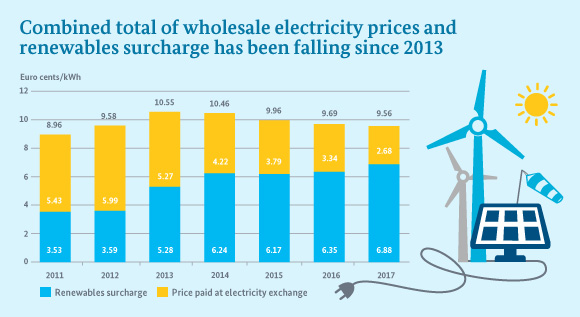Lower prices on electricity exchange make up for higher renewables surcharge
For four years now, the sum total of the power price paid at the electricity exchange and the renewables surcharge has been dropping. This means that utilities continue to obtain electricity at low prices. Consumers are well advised to look for the best tariff on offer.
 © Federal Ministry for Economic Affairs and Energy; data from calculations made by the ministry, based on data from www.netztransparenz.de and European Energy Exchange
© Federal Ministry for Economic Affairs and Energy; data from calculations made by the ministry, based on data from www.netztransparenz.de and European Energy Exchange
The purchasing price of electricity is continuing to drop slightly. It is true that next year will see the renewables surcharge being increased by half a cent to reach 6.88 euro cents per kilowatt hour, but the wholesale price for electricity is falling, not least thanks to the expansion of renewables capacity. As a result, 2016 marks the fourth year in which the sum total of the renewables surcharge and the price paid at the electricity exchange has fallen. This means that utilities can continue to obtain electricity at low prices, from both conventional and renewable sources.
State Secretary Baake: “We have taken the necessary steps”
“In undertaking the two reforms of the Renewable Energy Sources Act in 2014 and 2016 respectively, we have taken the necessary steps to gain control of the development of wholesale electricity prices”, said Rainer Baake, State Secretary at the Federal Ministry for Economic Affairs and Energy, speaking at an event in mid-October, at which the transmission system operators presented the new rate of the renewables surcharge. In 2013, wholesale electricity prices had peaked at 10.55 ct/kWh. Since then, they have consistently fallen year-on-year. The projected figure for 2017 is 9.56 ct/kWh, which is 1 ct/kWh less than the current price.
Consumers who want to benefit from this development are well advised to compare different utilities’ tariffs. This is because different utilities have taken different decisions as to whether and to what extent they pass on the lower wholesale prices they pay at the electricity exchange to their customers. Often, you will find that only new customers benefit from lower rates. Customers who use the competitive situation on the market to opt for a better tariff or a different utility may well find that they can save several hundreds of euros over a year.
What is the purpose of the renewables surcharge?
The renewables surcharge was introduced to finance the expansion of renewables. It ensures that operators of installations used to generate electricity from renewables will receive the level of remuneration they have been promised, even at times when wholesale electricity prices are low, as is currently the case. In other words, the renewables surcharge is there to close the gap between the income generated from renewables and the expenditure for renewables. Each year in mid-October, the transmission system operators publish the rate of the renewables surcharge for the following year. They do so on the basis of forecasts calculated by renowned research institutes. Any discrepancies between the forecast income and expenditure and the actual figures are logged in the “EEG account” and factored into the calculations for the following year (click here for more details).
The funding scheme for renewables is proving effective. The share of our electricity that is generated from renewables like solar or wind power has risen to about a third. Next year, the amount of electricity for which funding is provided by means of the renewables surcharge is projected to rise to 187 terawatt hours, which is a 40% increase over the figure from 2013.

